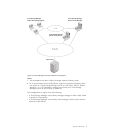
The storage agent communicates with the server to obtain and store database
information and to coordinate device and volume access. The server and client
coordinate and negotiate data access through the SAN. The client will use the
storage agent for operations where appropriate. For example, if a SAN path is
defined, the client (by means of the storage agent) transfers data on that path. If a
failure occurs on the SAN path, failover occurs and the client uses its LAN
connection to the Tivoli Storage Manager server and moves the client data over the
LAN.
There are cases when the storage agent can send the data directly to the server
using the LAN control paths between the storage agent and the server. An example
of this would be a LAN-free storage pool that is updated to read-only after the
client connects to the server and obtains its initial policy information. The storage
agent, instead of failing the operation, will send the data to the server, and,
providing that the storage hierarchy is configured so that the next storage pool
destination is available, the server will handle the operation. You can also prevent
data from transferring over the LAN by specifying the Tivoli Storage Manager
server parameters DATAREADPATH and DATAWRITEPATH with the REGISTER
NODE or UPDATE NODE commands for the desired node. These settings can be
reviewed by issuing the following command on the server for this node:
query node node_name format=detailed
Tivoli Storage Manager supports SAN-attached device sharing in one of the
following ways:
v Tivoli Storage Manager native library management support consisting of a
library manager and library clients or just a library manager. See “ACSLS, SCSI
and 349X Tape Library Sharing” on page 6 for details regarding libraries.
v Shared disk storage using a FILE library and the integration of Tivoli SANergy,
IBM TotalStorage SAN File System or other supported file-sharing software. For
current information about supported file-sharing software, see
www.ibm.com/software/sysmgmt/products/
support/IBMTivoliStorageManager.html.
v External libraries as defined in the Administrator’s Guide in the appendix,
″External Media Management Interface Description.″
For
additional information about these configurations, see “Types of
Environments” on page 5.
LAN-free Client Data Backup Scenario
The following outlines a typical backup scenario for a Tivoli Storage Manager
client that uses SAN data movement:
1. The client begins a backup operation. The server reports policy information to
the client, including whether a destination is LAN-free. As the client assigns
policy settings for files during backup processing, it sends the data LAN-free
when the destination for that policy is LAN-free enabled.
A storage pool is a LAN-free destination when the storage pool uses a device
shared on a SAN. That device must also have a defined path between the
device and the storage agent.
2. The storage agent receives data for those files backed up by the client and
assigned to policy settings that use a LAN-free enabled storage pool. The
storage agent sends a request for a volume mount to the library manager
server. In the external library case, the storage agent contacts the external
library manager, using the provided path to the executable.
Chapter 1. Storage Agent Overview 3
|
|
|
|
|


















